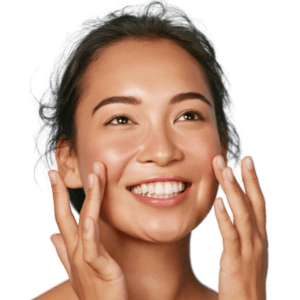"Illuminate your natural beauty, let your skin sing its true tune."
Age spots, often visible as small, dark patches on the skin, are signs of skin ageing that can affect anyone, though they are more prevalent in individuals with lighter skin. Despite their association with ageing, these spots are not exclusive to older adults; younger people can develop them too, especially if they have significant sun exposure. Understanding what age spots are, their causes, and their implications as a sign of ageing can help individuals make informed choices about skin care and treatment options.
At NU.U Clinic, the importance of personalised treatment is emphasised to ensure that each individual receives care that is specifically tailored to their unique skin needs. Recognising that each person’s skin is different, NU.U Clinic offers bespoke services and treatments designed to effectively target and reduce age spots, taking into account factors such as skin type, extent of sun damage, and overall skin health. By opting for personalised treatment, individuals can benefit from targeted strategies that not only address age spots but also contribute to the overall health of their skin.

Age Spots
Age spots, also known as liver spots or solar lentigines, are flat, brown, black, or grey spots that typically appear on areas of the skin that have been most exposed to the sun over the years, such as the face, hands, feet, shoulders, and upper back. These spots arise from the overproduction of melanin, the pigment that gives skin its colour, at the skin’s epidermis base due to repeated and prolonged sun exposure. While age spots vary in size and shape, they are generally larger than freckles and can group together, making them more noticeable.
Causes of Age Spots

Sun Exposure
UV radiation from the sun is the primary cause of age spots. When skin is exposed to the sun, it produces melanin to protect itself from UV damage. Over time, repeated exposure can cause melanin to clump together, forming visible age spots.

Ageing
As we age, the distribution of melanocytes (the cells that produce melanin) becomes less uniform, and their number may increase. This uneven distribution and accumulation can lead to the formation of age spots.

Skin Type
Individuals with lighter skin are more prone to age spots because they have less melanin, which provides some protection against UV radiation. Those with fair skin are more likely to develop age spots after sun exposure compared to individuals with darker skin tones.

Genetics
Family history can play a role in how susceptible you are to developing age spots. If your parents or siblings have age spots, you may be more likely to develop them as well.
Treatments for Age Spots

Dual Wavelength Long-Pulsed Laser / Alexandrite Laser Treatment
A combination of Alexandrite (755nm) and Nd:YAG (1064nm) wavelengths allows this laser treatment to target pigmentation, vascular concerns, and unwanted hair across various skin types. Adjustable settings enable tailored treatments based on individual needs while minimising the impact on surrounding tissue. A consultation with a qualified healthcare professional is recommended to determine suitability and expected outcomes. As with any procedure, individual results may vary.

Copper Bromide Yellow Laser
The Copper Bromide Yellow Laser is a skin treatment that targets pigmentation, acne, and vascular concerns while supporting overall skin rejuvenation. It delivers precise, controlled energy to the skin, helping to improve tone and texture with minimal impact on surrounding areas. Using yellow and green light wavelengths, this treatment is designed to address redness, uneven pigmentation, and other skin irregularities. As with any procedure, results vary from person to person, and a consultation with a qualified healthcare professional can help determine if this treatment is suitable for you.

Pico Laser
Pico laser treatment is a dermatological procedure used to address pigmentation concerns, acne scars, birthmarks, and tattoo removal. This laser delivers ultra-short pulses of energy to target specific skin concerns while minimising heat buildup. The treatment is designed to break down unwanted pigmentation and stimulate skin renewal. As with any procedure, individual results may vary, and a consultation with a qualified healthcare professional is recommended to determine suitability.

Ellipse I2PL
Ellipse I2PL (Intense Pulsed Light) is a versatile and non-invasive treatment technology used to address a variety of skin conditions. It employs a broad spectrum of light to target specific structures within the skin, depending on the condition being treated. Unlike lasers, which use a single wavelength of light, I2PL uses a multitude of wavelengths, allowing it to be customised for different skin issues and skin types. This adaptability makes Ellipse I2PL a sought-after choice for those seeking a safe and effective solution to their skin concerns.

Dual Wavelength Fractional Non Ablative Laser
The Dual Wavelength Fractional Non-Ablative Laser is a skin treatment that uses 1550 nm and 1927 nm wavelengths to target different skin layers. It is used to improve skin texture, wrinkles, scars, and pigmentation while maintaining the skin’s surface. This non-ablative approach delivers controlled laser energy to stimulate skin renewal with minimal downtime. It may also enhance skin permeability, which can support the absorption of certain topical treatments. As with any procedure, individual responses and outcomes may vary.

Hollywood Laser Toning
Hollywood Laser Toning is a laser-based treatment designed to rejuvenate skin and address pigmentation concerns. It targets skin issues such as melasma, acne scars, and fine lines, providing gentle improvements in overall skin appearance. This non-invasive procedure involves minimal recovery time, making it convenient for those seeking visible results without significant downtime.
Conclusion
In conclusion, age spots are a common skin concern that many individuals face as they grow older, often resulting from years of sun exposure. While they are usually harmless, they can be a significant cosmetic concern for those who wish to maintain a youthful and even skin tone. Fortunately, advancements in aesthetic treatments offer effective solutions for reducing the appearance of age spots, enhancing skin clarity and radiance.
Opting for personalised treatment is crucial in addressing age spots effectively, as it ensures that the approach is tailored to your specific skin type, concerns, and goals. Personalised treatments take into consideration the unique characteristics of your skin, delivering more targeted, efficient, and satisfying results.
Ultimately, addressing age spots through customised aesthetic treatments can boost confidence, rejuvenate your appearance, and reflect your inner vitality and beauty.
"Erase the echoes of sun-kissed years, reveal your timeless beauty."





 +65 6732 9989
+65 6732 9989 +65 9152 3582
+65 9152 3582